What is Change Management?
What is Change Management?
Since "Change" is a universal phenomenon that occurs all the time, to everything, then change management is "the process of coping with the effects of altered circumstances".
These changes (altered circumstances) may be caused by three sets of causes:
- Nature. (A hurricane may wreck your house)
- Other people. (Terrorists might bomb your house)
- Yourself. (You might leave the gas on and blow up your own house)
Change can be both negative and positive change; things can get better or worse, as a result of the change. Change management is the process by which one manages variations in circumstances initiated by nature, other people or yourself, either for good or for ill: meaning:
- How one manages the impact of a disaster.
- How one manages the impact of an alteration in the law.
- How one manages the impact of a new technology.
Change Management Models
There are five change management models that you need to know.
- The Locus of Control
- Four factors that cause change
- The five-part change management formula
- General Adaptation System (GAS)
- Difference between evolutionary change and revolutionary change
1. The Locus of Control

The fundamental question relating to change is: Who or what is driving the change?
- If the changes are being driven by forces that are outside your control, then the people affected by the change will feel disempowered.
- If the changes are being driven by forces WITHIN your control, then the people will feel empowered.
The task of the Change Manager is to focus the team's efforts onto those factors that they are able to control or influence, and to NOT waste too much energy dwelling on things over which they have NO control.
In addition, your aim is to always strive to extend your circle of influence and control. There are many factors that cause change to occur in your life. Which change factors can you control, and which can't you control?
2. Four factors that cause change
The four factors that cause change are:
- Yourself
- Other people
- Systems (political, social, information engineering, organisational, electronic systems)
- Mother nature (the weather, the environment, the climate, age etc)
Please note that you have direct control over the actions of only ONE item on the above list.
Can you guess which one it is?
As a Change Manager, your goals include:
- Control yourself. Keep your head.
- Influence others to adopt your ideas.
- Continually improve your systems, (political, social, information engineering, organisational, electronic systems).
In order to achieve the above four goals, use the success formula.
3. The five-part change management formula
This five-part change model lets you harness the power of change and make it work to your advantage.
All successful organisations reiterate a five-part process.
Purpose, plan, action, feedback, change.

- The goal is WHAT you want to achieve. Your desired state.
- The plan is the written document that is designed to get you to the desired state.
- The action is the implementation of the plan.
- The feedback are the results that your recent actions have created.
- The changes are the modifications, improvements and adaptations you need to make to your current plan, in order to achieve your goal.
Repeat the cycle until the goal is achieved.
4. The General Adaptation System (GAS)
As you can see from the above diagram, change is simple in theory but sometimes, not easy in practice.
Change is not easy because people find the process of change very stressful.
Change induces stress because it forces people to break their normal routines and habits; it throws them into a state of uncertainty. Most people don't like having their routines broken, and most hate uncertainty.
Therefore, you need to understand and to manage the emotional stress caused by change.
You need to know the General Adaptation System, which has four parts: Change. Alarm. Adaptation. Exhaustion.

- The initiation of the change.
- The alarm phase: when productivity tends to drop as an initial response to the announcement of the change.
- The adaptation phase: the adaptive response to changing environment; productivity increases.
- The exhaustion phase: when people get tired of the constant changes, they suffer from "change fatigue".
Your task is to help people through the alarm stage, get them into the adaptation phase and keep them away from exhaustion.
You must avoid change fatigue.
5. Difference between, evolutionary change and revolutionary change
Change comes in two varieties, evolutionary change and revolutionary change.
- Evolutionary change is slow, gradual, taken by means of small individual steps, and it leads to feelings of continuous improvement.
- Revolutionary change is the opposite type. Revolutions are rapid, done in one step and they are often, bloody affairs.
If you make your change process feel like revolution, then that would NOT be desirable to most people. Revolutions have a reputation for being painful and disruptive.
It would be better, if you could make change a progressive evolution.
What is PDCA?
PDCA is an acronym for a change management and continuous improvement process. PDCA stands for: Plan, Do, Check, Act. PDCA is a common model and it is known by many people.
We believe, however, that the model is deficient, and that it is easy to improve it. PDCA misses out too much detail and is therefore not a good enough model for you or your delegates.
We want to present a more refined and improved version of the PDCA process.
What is wrong with PDCA?
Before you can plan to do something, you must first know what that "something" is. Meaning, the first step in a process of change management is not to ask, "What is the plan?" but rather: the first step is to ask, "What is the goal?".
If you start with planning, you have missed a vital step. Instead, start with setting a clearly defined, well worded and objectively measurable goal.
Step one: State the purpose
Purpose, (goal, SMART target) is the first step. Smart target means: "Write down a Specific. Measurable. Achievable. Realistic. And Time limited, target".
Step two: Plan
Now you have the goal, now you can ask the team to formulate a plan of action.
- Identify all the steps that need to be taken.
- Identify how long each step will take.
- Identify what resources will be required.
- Identify the correct sequence of tasks.
- Figure out the critical path analysis.
- Put it all in writing and distribute it for critical evaluation and improvement.
Step three: implement the plan
Obviously the plan won't work unless you do. The plan must be implemented with skill, precision, accuracy and with honest hard work.
Step four: Identify where the plan is working
Meaning, the results you are creating by the implementation of your actions are the results you wanted, or even better than what you wanted.
Step five: Identify where the plan is not working
Meaning, the results you are creating by the implementation of your actions are NOT the results you wanted, or even worse, damaging your prospects for the achievement of the goal.
Step six: Change in the light of negative feedback
On the areas that are not working, you must ask and answer the following question, "What adjustments or changes do we need to make to the plan, (step 2) in order to rectify the situation and get this project back on track?"
Summary of the comparison between standard PDCA and the more advanced form
PDCA = Plan. Do. Check. Act. (We suggest that there is a missing vital element: Agree the GOAL!)
Our more advanced Success Formula is:
Purpose. Plan. Action. Positive Feedback. Negative feedback. Change.
- Purpose: define the goal.
- Plan: formulate the best plan in writing.
- Action. Implement the plan.
- Positive Feedback. Find out what is working.
- Negative feedback. Find out what is not working.
- Change. In relation to what is not working, what changes need to be made to the plan.
What is Change Management Training?
We offer change management training, designed to help people effectively manage change, by improving performance in terms of four key themes: Motivation, planning, communication, and implementation of continuous improvement. Here are the themes in more detail:
1. Motivation
Emotionally, people don't like change because we are all creatures of habit.
Change disrupts habits, which we find frustrating, annoying and difficult to deal with. However, change is inevitable. The only choice people have is either to:
- Adapt and benefit from the change in circumstances.
- Not adapt and not benefit from the change in circumstances.
Change management starts by helping people become more adaptive and less resistant to change. Since change is inevitable, it is better to accept the inevitable and strive to find ways to use it to our advantage.
We want people to be more philosophical and optimistic about change; to begin to think about how to turn changes to their advantage. Instilling the adaptive mindset is the first and most important topic in training change management.
2. Change management planning
A plan is a set of written, systematic, purposeful steps that are intended to achieve a predetermined goal.
Therefore, before a change plan can be written, the desired goal must already have been decided. In other words, change management should never be a knee-jerk reaction, in response to a change of circumstances. Change management should always be goal directed.
Change management is a series of deliberate acts intended to move people from the current state, to the desired future state, or goal.
For any change management programme to be effective, it must be well planned, and goal directed.
3. Communication
It is the responsibility of the change management team to communicate that the change is inevitable. They must communicate the new goal, the new plan, and the first steps.
The change management team must then communicate a sense of optimism for a better future. Change brings uncertainty and uncertainty brings doubt, and doubt brings negative emotions. These negative emotions must be countered, by the communication of reassurance that the world can be made better.
4. Implementation
Implementation of the plan is the final aspect of the change management process. The plan gives the theory of the change response. The implementation is putting theory into practice.
No plan is perfect, so there will be elements of the change plan that will fail. So the change team must be observing and measuring the feedback results of the plan's implementation.
Where the plan is working, it can be implemented according to plan. But where the plan is not working, then the change plan itself must be changed, in accordance with logical analysis of the evidence available.
Life settles down to a regular cycle of; action, feedback reaction, rewrite and change of plan.
This cycle is called the continuous improvement cycle.

We are pleased to offer our change management training as an in-house course, which can be delivered face-to-face or online, if you prefer.
Definition: Change management
In business, change management is a structured process that 1) agrees a clear goal, 2) builds a written plan, 3) leads people through the shift, and 4) uses feedback to adjust until the goal is met.
Show CG4D Definition
- Sets a specific, measurable goal for the future state
- Creates and documents the step-by-step plan to reach that goal
- Guides and supports people affected by the change
- Monitors results and revises actions until the goal is achieved
Article Summary
Research shows projects with strong change management are six times more likely to hit their goal, because clear purpose, smart plans, fast action and constant feedback turn raw change into steady progress.
Frequently Asked Questions
Here are some questions that frequently get asked about this topic during our training sessions.
What is the main goal of change management?
How does the locus of control affect change projects?
What are the four factors that cause change?
Can you summarise the five-part change management formula?
What is the General Adaptation System in change management?
How do evolutionary and revolutionary change differ?
Why is feedback crucial in a continuous improvement cycle?
Thought of something that's not been answered?
Did You Know: Key Statistics
Prosci’s 2023 Best Practices study found that projects with strong change management are six times more likely to reach their goals than projects with weak change management. PwC’s Global Workforce Hopes and Fears Survey 2024 reports that 62% of employees experienced at least one major workplace change in the past year, yet only 30% received any training to handle it.Blogs by Email
Do you want to receive an email whenever we post a new blog? The blogs contain article 5-10 minutes long - ideal for reading during your coffee break!
Further Reading in Change Management
-
Why Won't People Accept Change?
Learn why resistance to change blocks progress and follow clear, low-risk steps that help people accept change, build good habits and reach long goals.
Read Article > -
What are the Principles of Change Management?
Learn eight change management principles that give teams clear purpose, smart plans, focused action and feedback loops, turning resistance into progress.
Read Article > -
Leadership Training - The Universal Success Formula
Learn the universal success formula: purpose, plan, action, feedback and change. Apply it to leadership, money and health to improve results and reach any goal.
Read Article > -
Learning by Experience
Learn how learning from experience and watching others helps you break bad habits, sharpen time management, and spark continuous improvement for lasting growth.
Read Article > -
Effectively manage change
Master change management with the five-step success formula: set goals, plan action, track feedback, adjust and build a culture that turns risk into progress.
Read Article >
Looking for Change Management Training?
If you're looking to develop your Change Management Skills, you may find this Change Management Training Course beneficial:
Open Training Course Pricing and Availability
In-House Course Available Call us on 020 3856 3037 to discuss your requirements or






